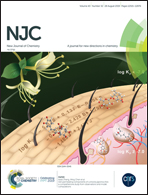New polymorphism and structural sensitivity in triphenylmethylphosphonium trihalide salts†
Abstract
In the course of our ongoing study of halogen bonding in cocrystals of organoiodine molecules with triiodide salts, we have isolated three of the four known polymorphs of triphenylmethylphosphonium triiodide (PPh3MeI3) and found that one of the tetramorphs exhibits a low temperature phase transition not previously described in the literature. Variable temperature crystallographic studies coupled with differential scanning calorimetry were used to determine the transition temperature and solid-state single crystal to single crystal reversibility of the phase change. To monitor the effect of the size of the anion, bromine was introduced to the reaction mixtures to produce trihalide salts (PPh3MeX3) having varying degrees of mixed iodine and bromine content. The resulting modification of anion size led to structural perturbations beyond those previously observed for the PPh3MeI3 polymorphs, giving three different structure types with similar but not identical packing arrangements of the ions. In addition to providing insight into the effect of subtle changes to crystal packing, the mixed trihalides offer structural and electronic tuning to the applicability of rod-shaped trihalides and functional halogen bonding acceptors.



 Please wait while we load your content...
Please wait while we load your content...